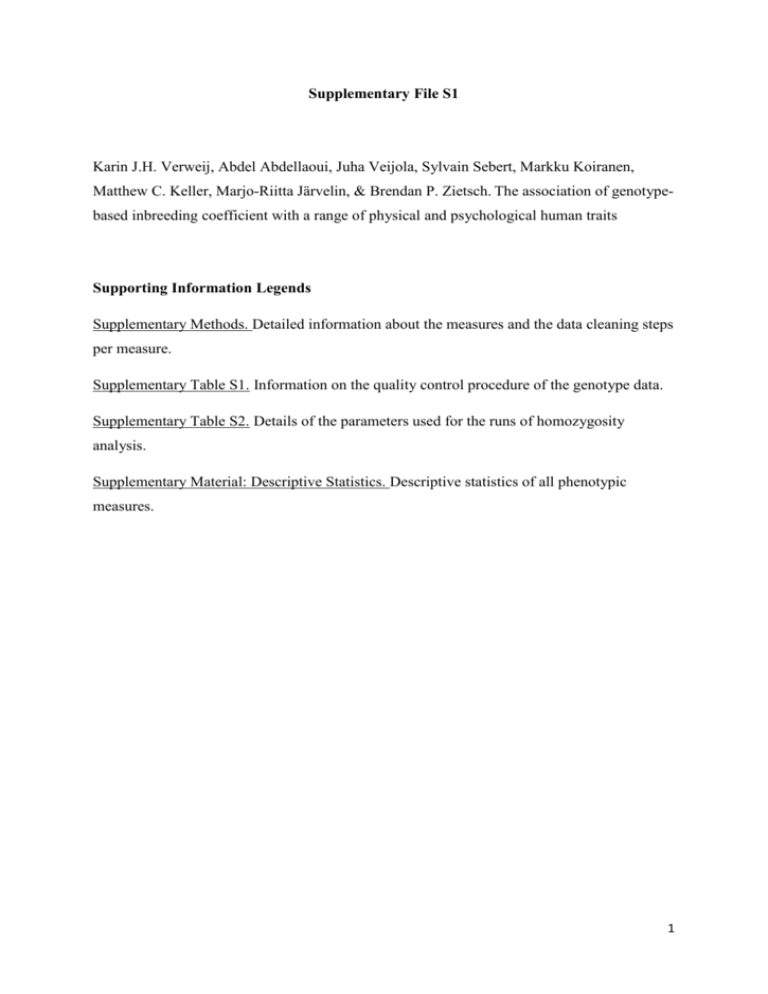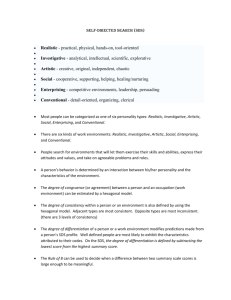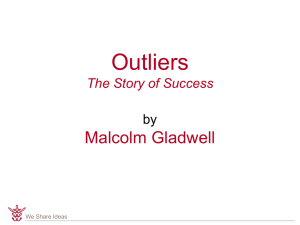Supplementary File S1 Karin J.H. Verweij, Abdel Abdellaoui, Juha
advertisement

Supplementary File S1 Karin J.H. Verweij, Abdel Abdellaoui, Juha Veijola, Sylvain Sebert, Markku Koiranen, Matthew C. Keller, Marjo-Riitta Järvelin, & Brendan P. Zietsch. The association of genotypebased inbreeding coefficient with a range of physical and psychological human traits Supporting Information Legends Supplementary Methods. Detailed information about the measures and the data cleaning steps per measure. Supplementary Table S1. Information on the quality control procedure of the genotype data. Supplementary Table S2. Details of the parameters used for the runs of homozygosity analysis. Supplementary Material: Descriptive Statistics. Descriptive statistics of all phenotypic measures. 1 Supplementary Methods: Description of the measures Measures from the postal questionnaire: 1. Marital Status was measured with the following questionnaire item: What is your marital status: 1. Married 2. Cohabiting 3. Single 4. Legal separation or divorced 5. Widowing Marital Status was converted into a dichotomous variable with 0=married/cohabiting and 1=single/legal separation or divorced. ‘Widowing’ was treated as missing. 2. Educational attainment was measured with the following questionnaire item: What is your occupational education? 1. No occupation education 2. Vocational training course 3. Vocational school 4. Post-secondary education 5. Polytechnic education 6. University degree 7. Some other education 8. Education unfinished Secondary education was standardised separately by sex and analysed as a continuous variable. ‘Some other education’ and ‘education unfinished’ were treated as missing. 3. Income was measured with the following open question: 2 What was the gross income of your household last year (gross income – including tax(in FIM/year)) Income was standardised separately by sex and winsorised at 3 SDs from the mean. 4. Life Satisfaction was measured with the following questionnaire item: How do you feel about your current life situation in general? 1. Very satisfied 2. Quite satisfied 3. Quite unsatisfied 4. Very unsatisfied 5. Cannot say Life Satisfaction was converted into an ordinal variable with three categories, where 0=very satisfied, 1=quite satisfied, and 2=quite unsatisfied/very unsatisfied. ‘Cannot say’ was treated as missing. 5. Handedness was measured with the following questionnaire item: Are you: 1. Right-handed 2. Left-handed 3. Capable of using both hands equally well Handedness was converted into a dichotomous variable, where 0= right-handed, and 1=left handed/ambidextrous. 6. Self-rated health was measured with the following questionnaire item: What is your own estimate about your health right now? 1. Very good 2. Good 3 3. Moderate 4. Bad 5. Very bad Self-rated health was converted into an ordinal variable with 4 categories, where 0=very good, 1=good, 2=moderate, and 3=bad/very bad. Then the variable was standardised separately for males and females. 7. Lifetime health problems was measured with the following question: Have you ever had any of the following symptoms, sicknesses, or injuries verified or treated by a doctor? Response options were: 1) no, 2) yes. 1. Elevated blood pressure, hypertension 2. Congenital heart disease 3. Cardiac insufficiency 4. Chest pain up on strain (angina pectoris) 5. Diabetes 6. Thyroiditis 7. Gastric or duodenal ulcer 8. Gallstones, gallbladder inflammation 9. Long-lasting of urinary tract infection mephitis 10. Ovaritis (women) 11. Prostatis (men) 12. Chlamydia infection 13. Condyloma 14. Herpes in genitals 15. Other infection in genitals 16. Aural infection 17. Ophthalmologic defect 18. Epilepsy 19. Migraine 20. Other neurological disease 4 21. Rheumatoid arthritis 22. Other arthritic condition 23. Degenerative or other back condition 24. Cancer 25. Hernia 26. Anaemia (low haemoglobin) 27. Mental illness, psychosis 28. Depression 29. Other mental health problem 30. Problems with alcohol 31. Other intoxicant problem 32. Fractures 33. Defect of occlusion requiring orthodontics treatment The Lifetime health problems variable was created by adding up the item responses. The sum scores were standardised separately by sex and outliers were winsorised at 3 SDs from the mean. Measures from the clinical examination: 8 & 9. Systolic and diastolic blood pressure (in Hg) were measured at a clinical examination. Both measures were taken twice. Systolic and diastolic blood pressure were analysed as continuous measures. Extreme outliers were removed (systolic blood pressure <= 50 mm Hg and >=230mm Hg, and diastolic blood pressure <=35 mm Hg and >=140 mm Hg), and individuals’ values were treated as missing if there was a large difference between the two systolic or the two diastolic measures (>=25 mm Hg). Subsequently, the two measures were averaged, standardised separately by sex, and outliers were winsorised at 3 SDs from the mean. 10. Heart rate (per 30 seconds) was measured at a clinical examination, while the participant was in a sitting position. 5 Heart rate was analysed as a continuous measure. Extreme outliers were removed (>=75 beats per 30 seconds). Subsequently, the variable was standardised separately by sex, and outliers were winsorised at 3 SDs from the mean. 11. Height (in cm with an accuracy of 0.1 cm) was measured at a clinical examination. Height was analysed as a continuous measure. Extreme outliers were removed (height < 1.30 meters). The variable was standardised separately by sex and outliers were winsorised at 3 SDs from the mean. 12. BMI was derived from height and weight (in kg with an accuracy of 0.1kg) obtained at a clinical examination. BMI was calculated by dividing weight in kg by height2 (in meters). BMI was analysed as a continuous variable. Extreme outliers for height (see above) and weight (weight <= 40kg) were removed. Subsequently, BMI was standardised separately by sex and outliers were winsorised at 3 SDs from the mean. 13. Waist-to-hip ratio was derived from hip and waist circumference measures (both in cm with an accuracy of 0.5 cm) obtained at a clinical examination. Waist-to-hip ratio was calculated as waist circumference divided by hip circumference. Past research has found that a waist-to-hip ratio of 0.7 is optimal, but only 4 males (0.2%) and 47 females (1.8%) had a waist-to-hip-ratio below 0.7, rendering it not worthwhile to use a ‘difference from optimum’ score. Waist-to-hip ratio was analysed as a continuous variable. The variable was standardised separately by sex and outliers were winsorised at 3 SDs from the mean. 14. Gripstrength (in kg with an accuracy of 0.1kg) was measured three times at a clinical examination. 6 The Grip strength variable comprised a composite measure of the three grip strength tests and was analysed as a continuous variable. Multivariate outliers were identified (using the Mahar test for multivariate outliers) and treated as missing. Subsequently, the three grip strength measures were averaged, standardised separately by sex, and winsorised at 3 SDs from the mean. 15. Birth-length was measured on a seven point Likert scale ranging from 1 (shorter than two standard deviations below the mean) to 7 (taller than 2 standard deviations above the mean). Birth-length was analysed as a continuous variable. The variable was standardised separately by sex. 16. Physical Anhedonia Scale was measured with the Revised Physical Anhedonia Scale (PAS, see Chapman et al, 1976), a 61 item scale measuring individuals’ ability to experience physical and sensory pleasures. Items were answered with true or false. Scale scores were derived by adding up the total item scores, with high scores indicating lowered ability to experience physical and sensory pleasures. If an individual had more than 10% missing items, the variable was treated as missing data; otherwise missing items were imputed based on the individual’s responses to the other items. The internal consistency of this measure (as determined in the current sample) is high (see Miettunen et al., 2010). Physical Anhedonia Scale was analysed as a continuous variable. The variable was standardised separately by sex, and outliers were winsorised at 3 SDs from the mean. 17. Social Anhedonia Scale was measured with the Revised Social Anhedonia Scale (SAS, see Chapman et al, 1976; Eckblad et al, 1982), a 40 item scale measuring individuals’ interest in social interaction. Items were answered with true or false. Scale scores were derived by adding up the total item scores, with high scores corresponding to schizoid lack of interest in social interaction. If an individual had more than 10% missing items, the variable was treated 7 as missing data; otherwise missing items were imputed based on the individual’s responses to the other items. The internal consistency of this measure (as determined in the current sample) is high (see Miettunen et al., 2010). Social Anhedonia Scale was analysed as a continuous variable. The variable was standardised separately by sex, and outliers were winsorised at 3 SDs from the mean. 18. Perceptual Aberration Scale was measured with the Perceptual Aberration Scale (PER, see Chapman et al, 1978), a 35 item scale measuring individuals’ perception of their own body and other objects. Items were answered with true or false. Scale scores were derived by adding up the total item scores, with high scores corresponding to a distorted perception of own body and other objects. If an individual had more than 10% missing items, the variable was treated as missing data; otherwise missing items were imputed based on the individual’s responses to the other items. The internal consistency of this measure (as determined in the current sample) is high (see Miettunen et al., 2010). Perceptual Aberration Scale was analysed as a continuous variable. The variable was standardised separately by sex, and outliers were winsorised at 3 SDs from the mean. 8 Supplementary Table S1. Genotype quality control information. Table includes initial number of SNPs and individuals, individuals not passing quality control (QC), SNPs not passing QC for Hardy-Weinberg equilibrium (HWE), minor allele frequency (MAF) and SNP call rate, number of SNPs and individuals after QC, and SNPs removed and retained after light pruning. Initial # of Initial # of Individuals HWE autosomal individuals SNP call Individuals SNPs after rate <95% after QC QC MAF <.05 removed p<10-3 SNPs 5,546 355,635 178 6,494 40,293 2,331 5,368 309,315 SNPs removed SNPs retained after light after light pruning pruning 124,406 184,909 Light LD pruning: Removal of SNPs using PLINK with the following parameters: window size in SNPs = 50, number of SNPs to shift the window at each step = 5, VIF > 10 (r2>0.9) 9 Supplementary Table S2. Parameters used for the Runs-of-Homozygosity analysis in PLINK, based on recommendations from Howrigan et al. (2011). ROH analysis, function parameters PLINK command Value used - SNP threshold to call a ROH --homozyg-snp 65 (after light pruning of SNPs) - Sliding window size in SNPs --homozyg-window-snp 65 (after light pruning of SNPs) - Heterozygote allowance --homozyg-window-het 0 - Missing SNP allowance --homozyg-window-missing 3 - Window threshold to call a ROH --homozyg-window-threshold 0.05% of SNP threshold - Sliding window size in kb --homozyg-window-kb 0 (unused) - Kb threshold to call a ROH --homozyg-kb 0 (unused) - Minimum SNP density to call a ROH --homozyg-density (kb) 5,000 (set high to ignore) - Maximum gap before splitting ROH --homozyg-gap (kb) 5,000 (set high to ignore) 10 Supplementary Material: Descriptive Statistics Continuous variables (after excluding outliers, before standardising, winsorising) Phenotype Males Females N M (SD) N M (SD) Height 2539 178.21 (6.40) 2768 164.77 (6.04) BMI 2538 25.21 (3.59) 2751 24.19 (4.70) Waist-to-hip ratio 2519 0.91 (0.06) 2601 0.81 (0.08) Diastolic blood pressure 2527 80.39 (11.33) 2752 74.63 (10.82) Systolic blood pressure 2530 130.28 (12.69) 2759 119.84 (12.24) Heart rate 2525 33.76 (5.27) 2762 35.81 (5.23) Grip strength 2478 47.19 (8.73) 2717 26.68 (6.03) Household income 2316 168,483 (86,545) 2472 177,451 (171,302) Lifetime health problems 2489 1.79 (1.51) 2692 2.29 (1.84) Physical Anhedonia Scale 2032 17.90 (7.38) 2500 12.66 (5.89) Social Anhedonia Scale 2030 11.07 (5.96) 2500 8.15 (4.78) Perceptual Aberration Scale 2030 2.10 (3.20) 2500 2.60 (3.36) 11 Ordinal/dichotomous variables: Marital status: Males (N=2538) Females (N=2766) 1 Married 1113 (43.9%) 1457 (52.7%) 2 Cohabiting 642 (25.3%) 650 (23.5%) 3 Single 696 (27.4%) 515 (18.6%) 4 Divorced/separated 87 (3.4%) 144 (5.2%) 5 Widow* 0 3 0 In a relationship 1755 (69.1%) 2107 (76.2%) 1 Single 783 (30.9%) 659 (23.8%) Males (N=2299) Females (N=2310) *Not included in analyses Educational attainment: 1 No occupation education 182 (7.9%) 165 (7.1%) 2 Vocational training course 140 (6.1%) 128 (5.5%) 3 Vocational school 1061 (46.2%) 552 (23.9%) 4 Post-secondary education 611 (26.6%) 1148 (49.7%) 5 Polytechnic education 56 (2.4%) 31 (1.3%) 6 University degree 249 (10.8%) 286 (12.4%) 7 Some other education* 133 317 8 Education unfinished* 93 133 Males (N=2541) Females (N=2779) *Not included in analyses Handedness: 1 Right-handed 2296 (90.4%) 2591 (93.2%) 2 Left-handed 204 (8.0%) 169 (6.1%) 3 Ambidextrous 41 (1.6%) 19 (0.7%) 0 Right-handed 2296 (90.4%) 2591 (93.2%) 1 Non right-handed 245 (9.6%) 188 (6.8%) 12 Life satisfaction: Males (N=2479) Females (N=2723) 1 Very satisfied 499 (20.1%) 627 (23.0%) 2 Quite satisfied 1702 (68.7%) 1901 (69.8%) 3 Quite unsatisfied 243 (9.8%) 169 (6.2%) 4 Very unsatisfied 35 (1.4%) 26 (1.0%) 5 Cannot say* 46 39 0 Very satisfied 499 (20.1%) 627 (23.0%) 1 Quite satisfied 1702 (68.7%) 1901 (69.8%) 2 Quite/very unsatisfied 278 (11.2%) 195 (7.2%) Males (N=2535) Females (N=2767) Not included in analyses Self-rated health: 1 Very good 358 (14.1%) 340 (12.3%) 2 Good 1331 (52.5%) 1486 (53.7%) 3 Moderate 765 (30.2%) 846 (30.6%) 4 Bad 70 (2.8%) 89 (3.2%) 5 Very bad 11 (0.4%) 6 (0.2%) 0 Very good 358 (14.1%) 340 (12.3%) 1 Good 1331 (52.5%) 1486 (53.7%) 2 Moderate 765 (30.2%) 846 (30.6%) 3 Bad/very bad 81 (3.2%) 95 (3.4%) 13 Birth length: Males (N=2453) Females (N=2652) 0 < 2 SDs below the mean 28 (1.1%) 41 (1.5%) 1 2 SDs to 10th percentile 400 (16.3%) 322 (12.1%) 2 10th to 25th percentile 471 (19.2%) 505 (19.0%) 3 25th-75th percentile 1144 (46.6%) 1314 (49.5%) 4 75th to 90th percentile 235 (9.6%) 329 (12.4%) 5 90th percentile to 2 SDs above the mean 125 (5.1%) 102 (3.8%) 6 > 2 SDs above the mean 50 (2.0%) 39 (1.5%) SD=Standard deviation 14 References Supplementary Material Chapman, L.J., Chapman, J.P., & Raulin, M.L. (1976). Scales for physical and social anhedonia. Journal of Abnormal Psychology, 85(4):374–382. Chapman, L.J., Chapman, J.P., & Raulin, M.L. (1978). Body-image aberration in schizophrenia. Journal of Abnormal Psychology, 87(4):399–407. Eckblad, M., Chapman, L.J., Chapman, J.P., & Mishlove, M (1982). The Revised Social Anhedonia Scale. Madison, Wis, USA: University of Wisconsin. Miettunen, J., Veijola, J., Freimer, N., Lichtermann, D., Peltonen, L., Paunio, T., Isohanni, M., Joukamaa, M., & Ekelund, J. (2010). Data on schizotypy and affective scales are gender and education dependent—study in the Northern Finland 1966 Birth Cohort. Psychiatry Research, 178(2):408–41 15







